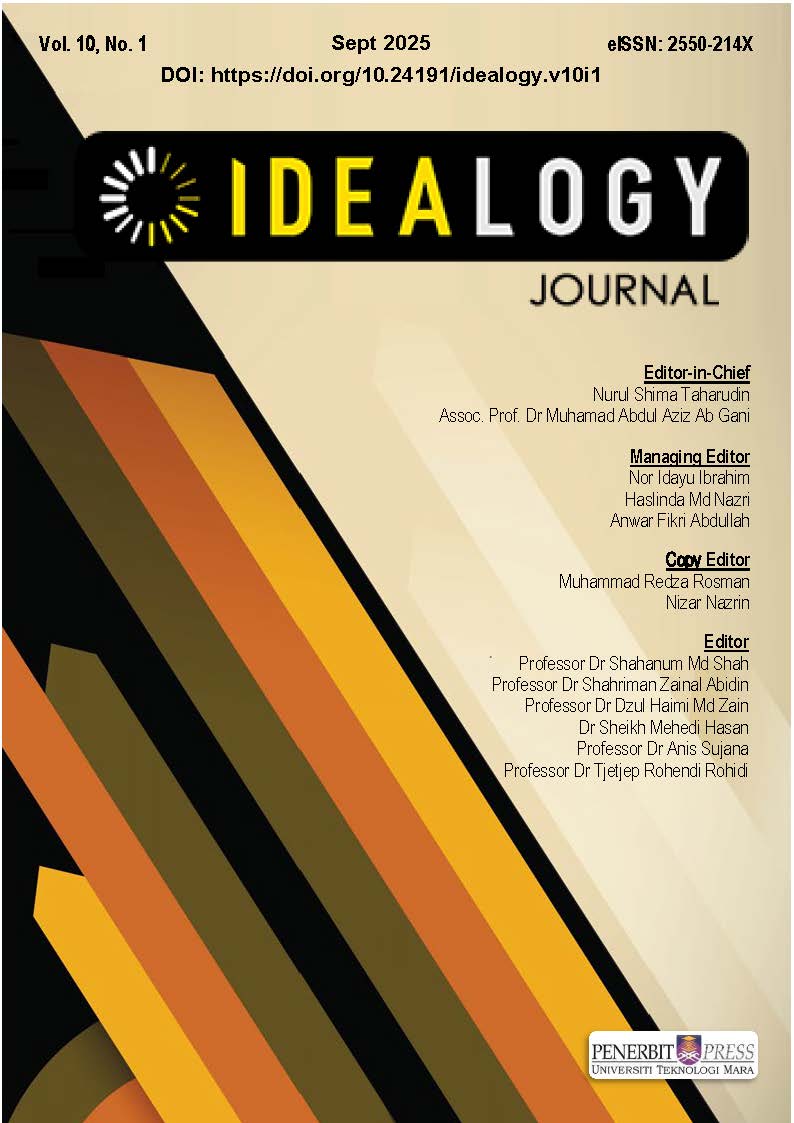Elements of Multimedia Used in the Jawi Mobile Application
DOI:
https://doi.org/10.24191/idealogy.v10i1.757Keywords:
Jawi script, Elements of Multimedia, Mobile Application, Arabic ScriptAbstract
Jawi script is derived from the Arabic script and contains six additional characters to represent Malay
vowel sounds. Mobile applications incorporate multimedia elements such as text, images, sound, video
and animation to enhance learning. This research aims to study and evaluate multimedia components
found in Jawi mobile applications. This research focuses on how multimedia elements are used and how
important they are to increasing user engagement and learning outcomes. This study uses content analysis
to evaluate multimedia elements in a selected sample of Jawi mobile applications. The main finding shows
no video content, although other multimedia elements are widely used. This indicates that there is room
for improvement in the design of these mobile applications, as video could increase user engagement and
Jawi mobile application developers should consider diversifying multimedia components to be more
interactive and dynamic.
Keywords: Jawi script, Elements of Multimedia, Mobile Application, Arabic Script
References
ANALISIS MENGENAI TEORI KANG KYOUNG SEOK (Historical Development of Jawi Script: Analysis to Theory of Kang Kyoung Seok). Journal of Al-Tamaddun, 9(2), 1–15. Retrieved from https://ejournal.um.edu.my/index.php/JAT/article/view/8673
Abdulrahaman, M. D., Faruk, N., Oloyede, A. A., Surajudeen-Bakinde, N. T., Olawoyin, L. A., Mejabi,
O. V., Imam-Fulani, Y. O., Fahm, A. O., & Azeez, A. L. (2020). Multimedia tools in the teaching and learning processes: A systematic review. Heliyon, 6(11), e05312. https://doi.org/10.1016/j.heliyon.2020.e05312
Bağcı, H., & Pekşen, M. F. (2018). Investigating the Smart Phone Addictions of Vocational School Students from Different Variables. Malaysian Online Journal of Educational Technology, 6(4), 40–52. https://doi.org/10.17220/mojet.2018.04.004
Banerjee, S. (2019). Elements of Multimedia (1st ed.). Chapman and Hall/CRC. https://doi.org/10.1201/9780429433207
Chen, S., & Xia, Y. (2012). Research on Application of Multimedia Technology in College Physical Education. Procedia Engineering, 29, 4213–
4217. https://doi.org/10.1016/j.proeng.2012.01.645
Coluzzi, P. (2020). Jawi is an endangered orthography in the Malaysian linguistic landscape. International Journal of Multilingualism, 19(4), 630–646. https://doi.org/10.1080/14790718.2020.1784178
e-JawiMakmur. (2021). Majlis Ugama Islam Dan Adat Resam Melayu Pahang. Retrieved December 17, 2024, from https://ejawimakmur.my/01-pendahuluan.html
Evans, C. (2007). The effectiveness of m-learning in the form of podcast revision lectures in higher education. Computers & Education, 50(2), 491–498. https://doi.org/10.1016/j.compedu.2007.09.016
Hj. Musa, Hashim (2005) Peranan tulisan Jawi dalam perkembangan Islam di Malaysia / Hashim Hj.
Musa. Jurnal Pengajian Melayu, 16. pp. 86-115. ISSN 1823-7622
Huda, S. (2024). Challenges of Using Multimedia Tools in the Teaching and Learning Process: Instance from a college of Bangladesh. Journal of Management and Business Education, 7(3), 435–451. https://doi.org/10.35564/jmbe.2024.0024
Krippendorff, K. (2013) Content Analysis. An Introduction to Its Methodology (3rd ed). California, CA: Sage Publications.
Downloads
Published
Issue
Section
License
Copyright (c) 2025 UiTM Press

This work is licensed under a Creative Commons Attribution-NonCommercial-NoDerivatives 4.0 International License.
UiTM Press (the Publisher) has agreed to publish the undersigned author’s paper in Idealogy Journal. The agreement is contingent upon the fulfilment of a number of requirements listed below.
1. The undersigned author warrants that the paper entitled below is original, that it is not in any way libellous or unlawful in Malaysia, that it does not infringe any copyright or other proprietary right. The undersigned hereby represents and warrants that he/she is the author of the paper, except for material that is clearly identified as to its original source, with permission notices from the copyright owners where required. The undersigned represents that he/she has the power and authority to sign and execute this agreement.
2. The undersigned author warrants that the paper entitled below has not been published elsewhere, and also it will not be submitted anywhere else for publication prior to acceptance/rejection by this Journal.
3. By submitting the paper entitled below, the undersigned author agrees to transfer the rights to publish and distribute the paper in an international e-journal (entitled above) to Publisher.
4. The undersigned author agrees to make a reasonable effort to conform to Publisher's submission guidelines and to liaise with the editor to ensure that the requirements of these guidelines are met to a reasonable degree.
5. The corresponding author signs for and accepts responsibility for releasing this material on behalf of any and all coauthors. This agreement is to be signed by at least one of the authors who has obtained the assent of the co-author(s) where applicable. After submission of this agreement signed by the corresponding author, changes of authorship or in the order of the authors listed will not be accepted.


